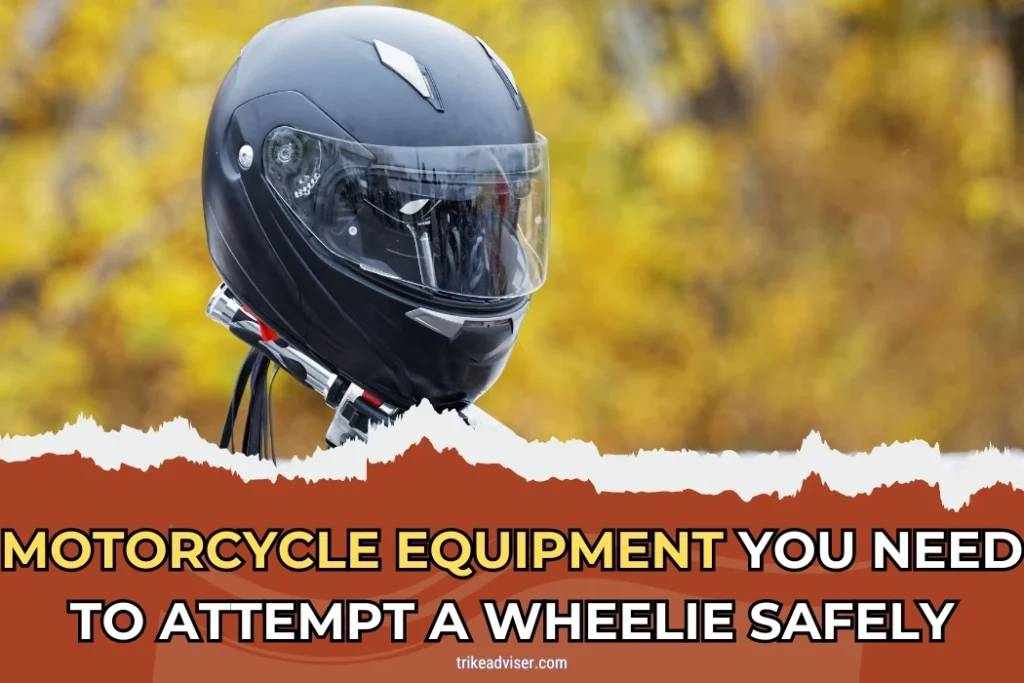Wheelies. We see them in movies, stunt shows, and on open roads. Always thrilling, but risky. Safety can’t be an afterthought when you’re balancing on one wheel.
It demands attention. Got the right gear? It’s crucial. Helmet, of course, but what about the other essentials? Gloves, boots, jackets, and pants—do they matter? Absolutely.
They protect your skin, joints, and bones. Will any gear do? No. Specific types of wheelies exist. Are they different from regular riding gear? Yes, they’re designed for high impact and flexibility.
Ready to shop for safety? Remember, quality over price. Cheaper isn’t better here. Safety gear is your lifeline. Don’t compromise.
Motorcycle Equipment You NEED to Attempt a Wheelie Safely
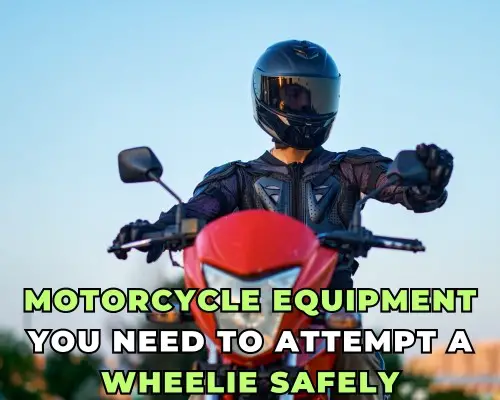
Helmet
Remember that first thrill of lifting the front wheel? Your helmet is your best friend from that moment. In crashes, 45% of all impacts occur to the frontal part of the helmet.
If you’re going up, make sure you’re geared to stay safe. Always opt for full-face helmets that meet DOT, ECE, or Snell certifications—these are your assurance of tested impact standards.
Protective Clothing
Think of your gear as your second skin. For wheelies, where falls are more common, padded clothing becomes crucial. Elbow and knee pads should come with reinforced padding and CE certification.
Gloves and jackets with palm sliders and back protectors absorb impact and provide that crucial slide, preventing more severe injuries like road rash or fractures.
Riding Gloves
Enhanced grip gloves with anti-vibration features not only improve your handlebar control but also reduce fatigue, letting you practice longer. Look for gloves with carbon fiber or thermoplastic knuckle guards—they’re a shield for your hands in a tumble.
Riding Boots
Ever notice how motocross riders brace their boots? It’s all about stability. For wheelies, select boots designed for riding, with oil-resistant, non-slip soles, and adequate ankle support.
High-quality boots can prevent the dreaded ankle twist during a bad landing, and believe me, that’s a game changer.
Chain Slack
That 1 inch of slack? It’s more important than you might think. Too tight, and you risk snapping a chain mid-wheelie—disastrous and dangerous. Too loose, and it could derail, equally nasty. Regular checks and adjustments keep the beast tame under stress.
Rear Brake Adjustment
Your rear brake is your emergency exit. Keep it within easy reach. A well-adjusted brake lever allows for quick reactions, crucial when you need to bring down the front wheel swiftly and safely.
Practice using it to modulate your landing—it can be the difference between a smooth finish and a harsh one.
Tire Pressure
Dropping to 15-20psi might not sound much, but it’s a sweet spot for traction. More contact with the road means better control when you lift off and when you come back down.
It’s like the difference between running shoes and flip-flops; one gives you the grip you need to push your limits safely.
Preparatory Steps for Wheelies
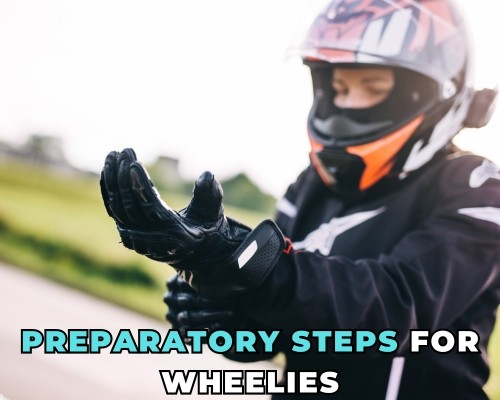
Mastering a wheelie isn’t just about pulling back on your throttle. It’s a calculated technique that begins with a deep understanding of your bike and setting it up precisely. Here’s how you can prepare efficiently and safely:
Understanding Your Motorcycle’s Capabilities
- Know Your Bike’s Power Band: Finding that ‘sweet spot’ in your bike’s power band—where the torque feels just right—is like finding the perfect pitch in music. It’s that mid-range RPM where your bike feels eager yet controllable, ready to lift but not lurch.
- Reaction to Braking and Acceleration: It’s important to understand how your bike responds to applying more pressure to the brakes or applying more gas. It’s similar to knowing precisely how much pressure (too much, and you’re in for a surprise) to apply to a Coke can before it explodes.
- Weight Distribution: Get to know how your bike balances. It’s like a seesaw; too much weight on one end and everything tilts. Adjust your sitting position until you find a spot where the bike feels ready to lift but not flip.
Just like the time I thought packing my duffle under the weight limit was a breeze. I ended up breaking the scale!
It taught me that what feels light might be quite heavy—similarly, what feels like a small tweak on your bike can have a big impact.
Mechanical Preparations: Bike Set-Up for Wheelies
- Suspension Adjustments: Soften the rear suspension to help the bike ‘sit’ just right—a bit like adjusting a chair before you sit, so it’s comfortable but not sagging. This makes the initial lift easier and more controlled.
- Tire Pressure: Think of the rear tire like a basketball. Too inflated, and it bounces uncontrollably; too deflated, and it doesn’t bounce at all. Aim for a pressure that gives grip yet allows for a bit of ‘give’ for smooth wheelies.
- Chain Tension: Ensure the chain is neither too tight nor too loose. It’s like tuning a guitar string—too tight, and it snaps; too loose, and it doesn’t play the right note. Proper tension means smooth transmission of power.
- Brakes: Your rear brake should be within easy reach and not too stiff. Practice using it gently, like tapping your fingers on a table to the rhythm of your favorite song. It can gracefully bring down the front wheel when needed.
Starting Right
- Begin with Power Wheelies: These involve careful throttle management—similar to pouring soda into a glass without letting it overflow. Start with small throttle bursts until you feel the front lifting naturally.
- Practice Makes Perfect: Choose a practice spot as carefully as a painter chooses a canvas. An empty parking lot or a quiet street can be your best bet. Here, you can focus on technique without distractions.
Safety Gear and Practices
- Wear Protective Gear: Put on protective gear and arm yourself as though you were about to fight. Not only are gloves, padded jackets, and helmets accessories; but they are essentials that keep you safe in case of an accident.
- Body Positioning: Lean back slightly, just like reclining in a chair to relax, but keep alert. This helps maintain the lift and gives you control.
Techniques for Safe Wheelies
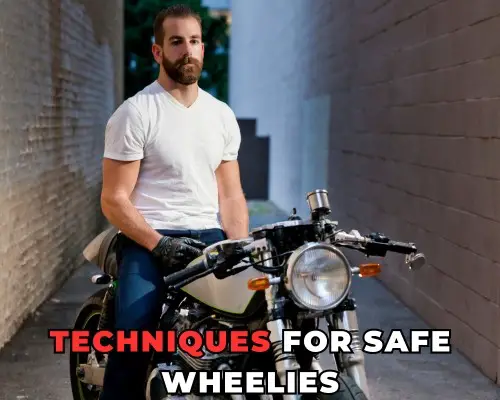
It takes a complex combination of dexterity, control, and in-depth knowledge of the response and mechanics of your motorcycle to master wheelies.
Let’s explore the intricacies of clutch and throttle control in more detail, walk you through your first wheelie, and point out typical mistakes to avoid.
Basics of Clutch and Throttle Control
- Understanding Clutch Control: The clutch in your motorcycle acts much like the control knobs in a delicate machine. It manages the fine line between power and control, letting you moderate the engine’s raw energy into manageable bursts.
Gradual engagement of the clutch allows for a smoother transition into a wheelie, minimizing the risk of jerking the bike upwards too aggressively.
Think of it as controlling the flow in a garden hose; too sudden and it splashes everywhere, just right and it waters effectively.
- Mastering Throttle Control: Gaining control over your bike’s throttle is crucial because it affects both the bike’s front lift and speed.
Controlling the throttle is similar to changing the music’s volume: too loud and it becomes noise, too low and you are unable to hear it.
Finding the sweet spot where the bike responds excitedly yet controllably is the aim. It requires a keen sense of your bike’s behavior under different RPMs, which only comes with experience and practice.
- Combining Both Skills: Marrying clutch and throttle control should feel intuitive over time, much like learning to drive a stick shift smoothly.
It’s about synchronizing your left hand with your right, achieving a balance that feels almost like a rhythmic dance.
Step-by-Step Guide to Your First Wheelie
- Choose a Safe Location: Much like selecting the perfect spot for a campsite, where it’s level and clear of obstructions, your practice area should be secluded, flat, and devoid of traffic. Safety is paramount when you’re learning, as it allows you to focus purely on technique.
- Optimize Your Bike Settings: Before you rev up, ensure your motorcycle is primed for the task. This includes setting the right tire pressure—slightly lower at the rear for better traction, adjusting your suspension to be softer at the rear to aid the lift, and ensuring your chain tension is perfect.
It’s akin to tuning a musical instrument before a performance; every detail contributes to the harmony of the outcome.
- Start Seated: Begin your wheelie journey with a seated position. It’s inherently more stable and gives you a better feel for managing the bike’s dynamics.
Gradually apply the throttle as you smoothly let out the clutch. It’s about feeling the bike wanting to lift rather than forcing it upwards.
- Progress to Standing Wheelies: Once comfortable with seated wheelies, try standing. This position offers more control and shifts your weight distribution, aiding in longer, more controlled wheelies.
It’s similar to switching from a sitting to a standing position in paddleboarding to get a better view and balance.
- Practice in First Gear: Starting in first gear is advisable as it provides ample power and easier control. It’s like learning to sprint in short bursts before running a marathon.
Common Mistakes and How to Avoid Them
- Avoid Excessive Throttle: An overly eager throttle can turn your wheelie attempt into a backward fall.
Apply the throttle as if you’re gradually pressing on a gas pedal in a powerful car—too much too soon, and you lose control.
- Keep a Finger on the Clutch: Always be ready to clutch in. It’s your quick disconnect in cases where the wheelie goes too high or feels out of control. Consider it a safety lever you can pull at any moment to regain stability.
- Be Smooth with the Throttle: Smooth operations ensure a controlled lift and a steady hold in the wheelie position.
Think of it as drawing a straight line with a ruler versus freehand—precision results in elegance and safety.
- Regular Practice: Consistency is key in mastering wheelies. Regular, focused practice not only builds muscle memory but also deepens your intuitive understanding of how your motorcycle reacts under various conditions.
Wheelies, while thrilling, are complex maneuvers that should be approached with respect and caution. Each session is a learning curve—treat it as an opportunity to refine your technique and deepen your connection with your bike.
Stay safe, practice diligently, and gradually build up to more advanced techniques as your confidence and skills grow
Safety Protocols and Emergency Measures
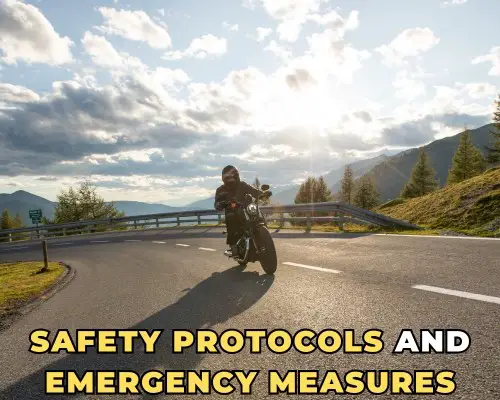
While wheelies can add an exhilarating edge to motorcycling, they also bring an extra layer of risk that demands respect and meticulous preparation.
Let’s dive deeper into robust safety protocols and emergency measures, ensuring that every thrilling maneuver remains within the bounds of safety.
What to Do If You Lose Control
- Stay Calm and Focused: It might sound like a cliché, but staying calm can significantly influence your ability to regain control. Imagine you’re navigating a tightrope; any sudden or panicked movements could throw off your balance completely.
- Create Space: If you start to lose control, think of it as needing more room to maneuver—a buffer zone. This is similar to an emergency stop in driving; the more space you have, the safer you will be.
- Maintain Awareness: Constant vigilance is crucial. It’s akin to a quarterback maintaining a pocket presence; being acutely aware of your surroundings can help you dodge unexpected tackles—or in this case, crashes.
- Gradual Braking: Apply your brakes gradually. Picture easing into a stop sign on a slick, snowy road—the gentler you are, the less likely you are to skid.
- Reduce Speed Sensibly: If a fall is inevitable, think about it as if you’re on a ladder and need to get down quickly but safely; slowing your descent step-by-step minimizes injury.
First Aid Tips for Riders: Handling Injuries Post-Fall
- DRABC Action Plan: This is your emergency framework. Think of DRABC as the emergency procedures flight attendants demonstrate before takeoff—vital in a crisis.
- Protect the Airway: Just as you clear debris from a storm drain to prevent flooding, ensure the injured person’s airway is clear. This can be crucial for preventing further complications.
- Control Bleeding: Apply pressure as if you’re trying to stop a water leak with your thumb—firm and direct. If possible, elevate the wound, which can help slow the bleeding, much like holding a bleeding finger above your heart.
- Prevent Movement: Immobilizing the injured person can be as crucial as securing a broken piece of valuable artwork during transport. Any movement can exacerbate injuries.
- Get Trained: Being trained in first aid is as essential as knowing how to change a tire—both are fundamental skills that can drastically change outcomes in critical moments.
Legal Considerations and Responsible Riding
- Understand Your Rights and Duties: Knowledge of road laws acts as your rulebook, similar to knowing the rules of a game—playing within them keeps everyone safe.
- Required Gear and Insurance: Suiting up with the correct gear and ensuring your bike is up to standard is as crucial as a knight wearing armor into battle. It’s both a protective and a legal requirement.
- Practice Defensive Riding: Imagine you’re a scout in unfamiliar territory; staying alert and anticipating the actions of others can make the difference between safety and peril.
- Seek Legal Help if Needed: After an incident, consulting with a motorcycle accident lawyer is akin to calling in a specialist when a simple fix isn’t enough. They provide the expertise needed to navigate complex situations.
Safety, when attempting wheelies, should never be an afterthought. Integrating these detailed safety measures and emergency protocols into your riding routine is like double-checking your parachute before a skydive.
Every precaution you take enhances your enjoyment by reducing risk, ensuring that the thrill of riding remains in your control.
Stay safe, stay prepared, and remember, wheelies are as much about skill and control as they are about excitement.
As an Amazon Associate, I earn from qualifying purchases, at no additional cost to you. Read Our Affiliate Disclosure.

